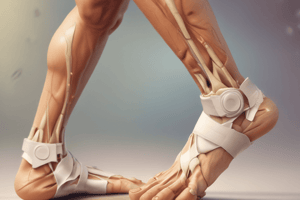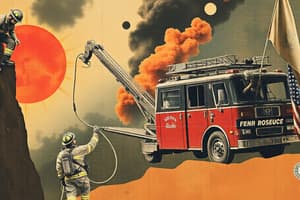Podcast
Questions and Answers
What is the primary function of the Main Line System?
What is the primary function of the Main Line System?
In which mode is the extrication of victims considered when they are believed to be biologically deceased?
In which mode is the extrication of victims considered when they are believed to be biologically deceased?
Who is responsible for managing all incident operations during a rescue?
Who is responsible for managing all incident operations during a rescue?
Which team member is responsible for establishing rope systems and overseeing the rescue team?
Which team member is responsible for establishing rope systems and overseeing the rescue team?
Signup and view all the answers
What type of device is used in the construction of the Main Line System?
What type of device is used in the construction of the Main Line System?
Signup and view all the answers
What color is the Main Line Bag, which carries essential rescue rope?
What color is the Main Line Bag, which carries essential rescue rope?
Signup and view all the answers
What is the role of Rescue Firefighter(s) within the team?
What is the role of Rescue Firefighter(s) within the team?
Signup and view all the answers
What does the term 'Hot Zone' refer to during operations?
What does the term 'Hot Zone' refer to during operations?
Signup and view all the answers
What is the primary responsibility of the Rescue Team?
What is the primary responsibility of the Rescue Team?
Signup and view all the answers
What system will the Safety Team construct?
What system will the Safety Team construct?
Signup and view all the answers
What must the Rescue Firefighter(s) wear before descending to the victims?
What must the Rescue Firefighter(s) wear before descending to the victims?
Signup and view all the answers
Which item is NOT part of the main line system for the Rescue Team?
Which item is NOT part of the main line system for the Rescue Team?
Signup and view all the answers
What type of hitch is specifically mentioned for use with the safety line system?
What type of hitch is specifically mentioned for use with the safety line system?
Signup and view all the answers
What should the Safety Team do in coordination with the Rescue Division?
What should the Safety Team do in coordination with the Rescue Division?
Signup and view all the answers
What is a key function of the Rescue Firefighter(s)?
What is a key function of the Rescue Firefighter(s)?
Signup and view all the answers
What is necessary to operate both the main line and safety line systems?
What is necessary to operate both the main line and safety line systems?
Signup and view all the answers
What should be done first regarding glass removal for a high-rise rescue operation?
What should be done first regarding glass removal for a high-rise rescue operation?
Signup and view all the answers
What safety measures must personnel take when removing glass from the exterior of a high-rise building?
What safety measures must personnel take when removing glass from the exterior of a high-rise building?
Signup and view all the answers
What should the Rescue Division do if a glazier cannot be located?
What should the Rescue Division do if a glazier cannot be located?
Signup and view all the answers
What is the role of the back-up team in a high-rise rescue operation?
What is the role of the back-up team in a high-rise rescue operation?
Signup and view all the answers
Who is responsible for scene safety during rescue operations?
Who is responsible for scene safety during rescue operations?
Signup and view all the answers
What must the Safety Officer ensure before any rescuer goes over the edge?
What must the Safety Officer ensure before any rescuer goes over the edge?
Signup and view all the answers
What is the primary role of the Rescue Team assigned by the Rescue Division?
What is the primary role of the Rescue Team assigned by the Rescue Division?
Signup and view all the answers
What is required of a back-up team in terms of safety gear?
What is required of a back-up team in terms of safety gear?
Signup and view all the answers
What should be used to cordon off the area below the victim(s)?
What should be used to cordon off the area below the victim(s)?
Signup and view all the answers
What protective gear must all Rescue Firefighter(s) wear at all times?
What protective gear must all Rescue Firefighter(s) wear at all times?
Signup and view all the answers
What is the purpose of the area defined as the debris zone?
What is the purpose of the area defined as the debris zone?
Signup and view all the answers
How should members located in elevated positions be secured?
How should members located in elevated positions be secured?
Signup and view all the answers
What type of helmet must be worn during rescue operations?
What type of helmet must be worn during rescue operations?
Signup and view all the answers
What is the role of support members during rescue operations?
What is the role of support members during rescue operations?
Signup and view all the answers
What attire is prohibited for members working at height?
What attire is prohibited for members working at height?
Signup and view all the answers
What should be communicated to the Rescue Division during operations?
What should be communicated to the Rescue Division during operations?
Signup and view all the answers
Who is ultimately responsible for the scene during a rescue operation?
Who is ultimately responsible for the scene during a rescue operation?
Signup and view all the answers
What is the primary goal during rescue operations?
What is the primary goal during rescue operations?
Signup and view all the answers
What should be done once an extricated victim is in a safe location?
What should be done once an extricated victim is in a safe location?
Signup and view all the answers
What action is required when portable radios are not possible during operations?
What action is required when portable radios are not possible during operations?
Signup and view all the answers
What should happen to equipment after returning to the fire station post-operation?
What should happen to equipment after returning to the fire station post-operation?
Signup and view all the answers
Who is responsible for inspecting equipment utilized in incidents?
Who is responsible for inspecting equipment utilized in incidents?
Signup and view all the answers
When is the routine monthly maintenance for high angle rescue equipment scheduled?
When is the routine monthly maintenance for high angle rescue equipment scheduled?
Signup and view all the answers
What should the Incident Commander do if an event attracts media attention?
What should the Incident Commander do if an event attracts media attention?
Signup and view all the answers
Study Notes
High & Low Angle Rescue Operations
- Hot Zone: Area defined by victim's location where lowering/hauling, safety systems, and anchor points are established.
- Incident Commander (IC): Responsible for all incident operations, including overseeing rescue efforts.
- Main Line Bag: Red bag on Rescue 71 containing red rescue rope and equipment for establishing lowering/hauling systems.
- Main Line System: Independent rope and anchor system attached to the rescuer and/or patient. Constructed using an independent anchor point, red rescue rope, and a MPD or Rappel Rack.
- Rescue Mode: Incident involving extrication and care of victims, where biological death has not occurred.
- Recovery Mode: Extrication of deceased or likely deceased victims, not an emergency function.
- Rescue Division: Manages tactical rescue objectives and oversees rope systems and personnel. Must be trained to at least the operations levels of NFPA 1006 and 1670.
- Rescue Firefighter(s): Trained SFD or mutual-aid rescue team member assigned to conduct rescue or recovery operations. Must be trained to at least the operations levels of NFPA 1006 and 1670.
- Safety Officer: Responsible for scene safety, including safety checks and constant observation of rescue personnel.
- Rescue Team: Constructs and operates lowering and/or hauling systems, responsible for identifying anchor points and operating the main line system.
- Safety Team: Constructs and operates safety line systems, responsible for identifying anchor points and operating the safety line system.
- Ground Control: Defines and protects the debris zone below the victim(s), restricts public access.
-
Rescue Firefighter(s) Responsibilities:
- Coordinate with Rescue Division to identify the most effective rescue or recovery method.
- Don full body harnesses and related safety equipment.
- Descend to the victim while attached to lowering and safety systems.
- Communicate victim's medical needs to the Rescue Division.
- Disentangle victims from lowering systems or related entrapment.
- Package and prepare the patient for removal.
- Connect lowering/hauling systems to the evacuation harness or patient packaging device and conducts safety checks before retrieval.
- Communicate patient or rescue firefighter needs to the Rescue Division until the rescue or recovery is completed.
Safety
- All Rescue Firefighter(s) or back-up Rescue Firefighter(s) must wear an SFD owned harness at all times.
- Members working within the Hot Zone may be required to wear a harness at the discretion of the Rescue Division or Safety Officer.
- Members located in elevated positions must be tied off to a fixed anchor point when working within 3ft of an edge.
- Rescue Team Members are issued an NFPA rated CMC uniform belt for edge protection.
- Members shall not wear bunker gear while working at height.
- Support members shall not be used for the construction or primary operation of lowering, hauling, or safety line systems.
- The incident commander is ultimately responsible for the scene, however the Rescue Division or Deisgnee commands all raising, lowering, and safety functions from the time rescuers are online until operations have been completed.
Hand Signals
- One Hand extended above head: Distress, need assistance.
- One Hand on Head: Okay.
- Point left/right: Move left or right.
- Both arms crossed above head: Stop.
- Both arms crossed in front of chest: Need Medical Kit and Help.
Equipment Maintenance
- All rescue equipment must be inspected and cleaned after use.
- Any used rope, webbing, anchor strap, or related nylon-based equipment must be inspected by a qualified Rescue Team Member in accordance with NFPA 1858.
- Inspections are recorded in PSTrax.
- Damaged, lost, or non-operational equipment must be reported to the SFD Logistics Division.
- SFD Rescue Team Members are responsible for routine monthly maintenance of all high-angle rescue software and hardware.
- Monthly equipment inspections must be recorded in PSTrax.
Studying That Suits You
Use AI to generate personalized quizzes and flashcards to suit your learning preferences.
Related Documents
Description
Test your knowledge on high and low angle rescue operations. This quiz covers definitions and roles of incident command, rescue modes, and equipment used in these rescue scenarios. Challenge yourself with key terms and processes essential for effective rescue operations.




